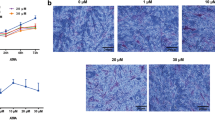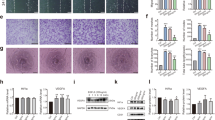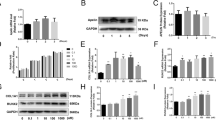Abstract
Distraction osteogenesis (DO) is a widely applied technique in orthopedics surgery, which involves rapid stem cell migration, homing, and differentiation. Interactions between the chemokine receptor Cxcr4 and its ligand, stromal derived factor-1 (SDF-1), regulate hematopoietic stem cell trafficking to the ischemic area and induce their subsequent differentiation. Here, we examined SDF-1 expression and further investigated the role of SDF-1/Cxcr4 signaling antagonist AMD3100 during bone regeneration in rat DO model. The results showed that expression levels of SDF-1 and osteogenic genes were higher in DO zones than in the fracture zones, and SDF-1 expression level was the highest at the termination of the distraction phase. Radiological, mechanical, and histological analyses demonstrated that the local administration of AMD3100 (400 μM) to DO rats significantly inhibited new bone formation. In the rat bone marrow mesenchymal stem cells culture, comparing to the group treated with osteogenic induction medium, AMD3100 supplement led to a considerable decrease in the expression of alkaline phosphatase and early osteogenic marker genes. However, the amount of calcium deposits in rat MSCs did not differ between the groups. Therefore, our study demonstrated that the DO process induced higher expression of SDF-1, which collated to rapid induction of callus formation. Local application of SDF-1/Cxcr4 signaling antagonist AMD3100 significantly inhibited bone mineralization and osteogenesis in DO, which may represent a potential therapeutic approach to the enhancement of bone consolidation in patients undergoing DO.








Similar content being viewed by others
References
Ilizarov GA (1990) Clinical application of the tension-stress effect for limb lengthening. Clin Orthop Relat Res 250:8–26
Ai-Aql ZS, Alagl AS, Graves DT, Gerstenfeld LC, Einhorn TA (2008) Molecular mechanisms controlling bone formation during fracture healing and distraction osteogenesis. J Dent Res 87(2):107–118
Ilizarov GA (1989) The tension-stress effect on the genesis and growth of tissues. Part I. The influence of stability of fixation and soft-tissue preservation. Clin Orthop Relat Res 238:249–281
Simpson AH, Kenwright J (2000) Fracture after distraction osteogenesis. J Bone Joint Surg Br 82(5):659–665
Carvalho RS, Einhorn TA, Lehmann W, Edgar C, Al-Yamani A, Apazidis A, Pacicca D, Clemens TL, Gerstenfeld LC (2004) The role of angiogenesis in a murine tibial model of distraction osteogenesis. Bone 34(5):849–861. doi:10.1016/j.bone.2003.12.027
Colnot C, Thompson Z, Miclau T, Werb Z, Helms JA (2003) Altered fracture repair in the absence of MMP9. Development 130(17):4123–4133
Lee DY, Cho TJ, Lee HR, Park MS, Yoo WJ, Chung CY, Choi IH (2010) Distraction osteogenesis induces endothelial progenitor cell mobilization without inflammatory response in man. Bone 46(3):673–679. doi:10.1016/j.bone.2009.10.018
Fujio M, Yamamoto A, Ando Y, Shohara R, Kinoshita K, Kaneko T, Hibi H, Ueda M (2011) Stromal cell-derived factor-1 enhances distraction osteogenesis-mediated skeletal tissue regeneration through the recruitment of endothelial precursors. Bone 49(4):693–700. doi:10.1016/j.bone.2011.06.024
Petit I, Jin D, Rafii S (2007) The SDF-1-CXCR4 signaling pathway: a molecular hub modulating neo-angiogenesis. Trends Immunol 28(7):299–307. doi:10.1016/j.it.2007.05.007
Wynn RF, Hart CA, Corradi-Perini C, O’Neill L, Evans CA, Wraith JE, Fairbairn LJ, Bellantuono I (2004) A small proportion of mesenchymal stem cells strongly expresses functionally active CXCR4 receptor capable of promoting migration to bone marrow. Blood 104(9):2643–2645. doi:10.1182/blood-2004-02-0526
Pead MJ, Skerry TM, Lanyon LE (1988) Direct transformation from quiescence to bone formation in the adult periosteum following a single brief period of bone loading. J Bone Miner Res 3(6):647–656. doi:10.1002/jbmr.5650030610
Hosogane N, Huang Z, Rawlins BA, Liu X, Boachie-Adjei O, Boskey AL, Zhu W (2010) Stromal derived factor-1 regulates bone morphogenetic protein 2-induced osteogenic differentiation of primary mesenchymal stem cells. Int J Biochem Cell Biol 42(7):1132–1141. doi:10.1016/j.biocel.2010.03.020
De Falco E, Porcelli D, Torella AR, Straino S, Iachininoto MG, Orlandi A, Truffa S, Biglioli P, Napolitano M, Capogrossi MC, Pesce M (2004) SDF-1 involvement in endothelial phenotype and ischemia-induced recruitment of bone marrow progenitor cells. Blood 104(12):3472–3482. doi:10.1182/blood-2003-12-4423
Wright LM, Maloney W, Yu X, Kindle L, Collin-Osdoby P, Osdoby P (2005) Stromal cell-derived factor-1 binding to its chemokine receptor CXCR4 on precursor cells promotes the chemotactic recruitment, development and survival of human osteoclasts. Bone 36(5):840–853. doi:10.1016/j.bone.2005.01.021
Askari AT, Unzek S, Popovic ZB, Goldman CK, Forudi F, Kiedrowski M, Rovner A, Ellis SG, Thomas JD, DiCorleto PE, Topol EJ, Penn MS (2003) Effect of stromal-cell-derived factor 1 on stem-cell homing and tissue regeneration in ischaemic cardiomyopathy. Lancet 362(9385):697–703. doi:10.1016/S0140-6736(03)14232-8
Abbott JD, Huang Y, Liu D, Hickey R, Krause DS, Giordano FJ (2004) Stromal cell-derived factor-1alpha plays a critical role in stem cell recruitment to the heart after myocardial infarction but is not sufficient to induce homing in the absence of injury. Circulation 110(21):3300–3305. doi:10.1161/01.CIR.0000147780.30124.CF
Toupadakis CA, Wong A, Genetos DC, Chung DJ, Murugesh D, Anderson MJ, Loots GG, Christiansen BA, Kapatkin AS, Yellowley CE (2012) Long-term administration of AMD3100, an antagonist of SDF-1/CXCR4 signaling, alters fracture repair. J Orthop Res 30(11):1853–1859. doi:10.1002/jor.22145
Hatse S, Princen K, Bridger G, De Clercq E, Schols D (2002) Chemokine receptor inhibition by AMD3100 is strictly confined to CXCR4. FEBS Lett 527(1–3):255–262
Xu J, Wu T, Sun Y, Wang B, Zhang J, Lee WY, Chai Y, Li G (2016) Staphylococcal enterotoxin C2 expedites bone consolidation in distraction osteogenesis. J Orthop Res. doi:10.1002/jor.23372
Liu C, Weng Y, Yuan T, Zhang H, Bai H, Li B, Yang D, Zhang R, He F, Yan S, Zhan X, Shi Q (2013) CXCL12/CXCR4 signal axis plays an important role in mediating bone morphogenetic protein 9-induced osteogenic differentiation of mesenchymal stem cells. Int J Med Sci 10(9):1181–1192. doi:10.7150/ijms.6657
Xu J, Wang B, Sun Y, Wu T, Liu Y, Zhang J, Lee WY, Pan X, Chai Y, Li G (2016) Human fetal mesenchymal stem cell secretome enhances bone consolidation in distraction osteogenesis. Stem Cell Res Ther 7(1):134. doi:10.1186/s13287-016-0392-2
Hong P, Boyd D, Beyea SD, Bezuhly M (2013) Enhancement of bone consolidation in mandibular distraction osteogenesis: a contemporary review of experimental studies involving adjuvant therapies. J Plast Reconstr Aesthet Surg 66(7):883–895. doi:10.1016/j.bjps.2013.03.030
Davidson EH, Sultan SM, Butala P, Tutela JP, Canizares O, Wagner IJ, Knobel D, Saadeh PB, Warren SM (2011) Augmenting neovascularization accelerates distraction osteogenesis. Plast Reconstr Surg 128(2):406–414. doi:10.1097/PRS.0b013e31821e6e2e
Ceradini DJ, Kulkarni AR, Callaghan MJ, Tepper OM, Bastidas N, Kleinman ME, Capla JM, Galiano RD, Levine JP, Gurtner GC (2004) Progenitor cell trafficking is regulated by hypoxic gradients through HIF-1 induction of SDF-1. Nat Med 10(8):858–864. doi:10.1038/nm1075
Pacicca DM, Patel N, Lee C, Salisbury K, Lehmann W, Carvalho R, Gerstenfeld LC, Einhorn TA (2003) Expression of angiogenic factors during distraction osteogenesis. Bone 33(6):889–898
Li G, Simpson AH, Kenwright J, Triffitt JT (1999) Effect of lengthening rate on angiogenesis during distraction osteogenesis. J Orthop Res 17(3):362–367. doi:10.1002/jor.1100170310
Wang XX, Allen RJ Jr, Tutela JP, Sailon A, Allori AC, Davidson EH, Paek GK, Saadeh PB, McCarthy JG, Warren SM (2011) Progenitor cell mobilization enhances bone healing by means of improved neovascularization and osteogenesis. Plast Reconstr Surg 128(2):395–405. doi:10.1097/PRS.0b013e31821e6e10
Kitaori T, Ito H, Schwarz EM, Tsutsumi R, Yoshitomi H, Oishi S, Nakano M, Fujii N, Nagasawa T, Nakamura T (2009) Stromal cell-derived factor 1/CXCR4 signaling is critical for the recruitment of mesenchymal stem cells to the fracture site during skeletal repair in a mouse model. Arthritis Rheum 60(3):813–823. doi:10.1002/art.24330
Leucht P, Temiyasathit S, Russell A, Arguello JF, Jacobs CR, Helms JA, Castillo AB (2013) CXCR4 antagonism attenuates load-induced periosteal bone formation in mice. J Orthop Res 31(11):1828–1838. doi:10.1002/jor.22440
Granero-Molto F, Weis JA, Miga MI, Landis B, Myers TJ, O’Rear L, Longobardi L, Jansen ED, Mortlock DP, Spagnoli A (2009) Regenerative effects of transplanted mesenchymal stem cells in fracture healing. Stem Cells 27(8):1887–1898. doi:10.1002/stem.103
Luan J, Cui Y, Zhang Y, Zhou X, Zhang G, Han J (2012) Effect of CXCR4 inhibitor AMD3100 on alkaline phosphatase activity and mineralization in osteoblastic MC3T3-E1 cells. Biosci Trends 6(2):63–69
Acknowledgements
The work was partially supported by grants from National Natural Science Foundation of China (NSFC Nos. 81371946, 81374568), Hong Kong Government Research Grant Council, General Research Fund (CUHK470813 and 14119115), and a project grant from China Shenzhen City Science and Technology Bureau (JGJHZ20140419120051680 and JCYJ20150630165236960) to Gang Li. This study was also partly supported by SMART program, Lui Che Woo Institute of Innovative Medicine, The Chinese University of Hong Kong.
Author information
Authors and Affiliations
Corresponding authors
Ethics declarations
Conflict of interest
Jia Xu, Yuanfeng Chen, Yang Liu, Jinfang Zhang, Qinglin Kang, Kiwai Ho, Yimin Chai, and Gang Li declare that they have no conflict of interest.
Human and Animal Rights and Informed Consent
All animal experiments were carried out under the animal license issued by the Hong Kong SAR Government and the approval of the Animal Experimentation Ethics Committee of the Chinese University of Hong Kong (Ref No. 14-052-MIS).
Additional information
Jia Xu and Yuanfeng Chen contributed equally as first authors.
Rights and permissions
About this article
Cite this article
Xu, J., Chen, Y., Liu, Y. et al. Effect of SDF-1/Cxcr4 Signaling Antagonist AMD3100 on Bone Mineralization in Distraction Osteogenesis. Calcif Tissue Int 100, 641–652 (2017). https://doi.org/10.1007/s00223-017-0249-4
Received:
Accepted:
Published:
Issue Date:
DOI: https://doi.org/10.1007/s00223-017-0249-4




